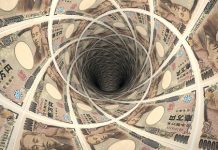In focus today
In the US, we will receive the second revision of GDP final. We do not anticipate a significant impact on market movements.
In the euro area, monetary aggregates and credit data will be released. As the ECB continues its active discussions on restrictiveness of monetary policy – pivotal for rate decisions – data on credit growth will be crucial. Credit growth has increased to approximately 2% y/y for the private sector, following the recent easing of monetary policy. However, momentum (the credit impulse) has remained flat at around 1% over the past six months, which, in our view, suggests that monetary policy remains tight. There is also a string of ECB speeches, including Schnabel, scheduled today.
In Norway, we anticipate Norges Bank will cut the policy rate to 4.25%, as signalled. This is a non-consensus view, as market pricing and consensus suggest only a 25-30 % probability of a cut. Admittedly, the inflation figures for February were significantly higher than expected and will contribute to a higher rate path. However, we anticipate that the monetary policy analysis will conclude that the combination of declining inflation, below-normal capacity utilization and restrictive monetary policy strongly supports lower rates. Although we expect the upcoming monetary policy report to adjust the rate path upwards by 25-30bp., it is still likely to indicate about two cuts in 2025, with further reductions planned for 2026-2028. In that case, it should be possible to stick to the plan and cut the policy rate already at this crossroad.
Economic and market news
What happened overnight
In the US, President Trump has announced a 25% tariff on imports of foreign-made vehicles as well as car parts. The tariffs will go into effect on 2 April as part of a series of other tariffs set to be implemented on “Liberation Day”. The announcement has already faced criticism, including from the EU and Canada, which will take measures to protect their interests.
What happened yesterday
In the US, February’s durable goods orders data showed a 0.9% increase, outperforming expectations (cons: -1.0%), yet it did not lead to further market reactions.
In the evening Fed’s Musalem cautioned that tariffs could lead to more persistent inflation, potentially exceeding the Fed’s 2% target and requiring tighter monetary policy.
In the UK, February inflation came in to the low side with headline and core inflation lower than expected at respectively 2.8% y/y (cons: 3.0%, prior: 3.0%) and 3.5% y/y (cons: 3.6%, prior: 3.7%). Services remained unchanged at 5.0% y/y (cons: 4.9%, prior: 5.0%). More broadly, inflationary pressures eased, and inflation is currently at or below the Bank of England’s expectations, paving the way for another cut at the upcoming meeting. We will receive another inflation print before the next meeting in May. In the afternoon, the Labour government presented its Spring statement, which was overall in line with expectations with Chancellor Reeves aiming to reassure markets of the government’s commitment to fiscal sustainability. Gilts initially reacted strongly but ended the day with benchmark yields only 1-3bp lower, supported by a downside surprise to inflation figures released earlier in the day.
In Sweden, The Economic Tendency Survey from NIER indicated a negative outlook for the economy, with decreased confidence, particularly among consumers, indicating a weaker sentiment than usual. Households are pessimistic about both their current economic situation and outlook. Pricing plans rose further in March and are now significantly above normal levels. This accelerates the stagflation trend, creating a more challenging environment for the Riksbank.
The Minutes from last week’s Riksbank meeting was also released yesterday. The Board communicated a balanced view, acknowledging inflation risks but suggesting the recent uptick is temporary, while emphasising the need for ongoing economic support. Despite concerns over stagflationary trends, they maintain a positive outlook for inflation and activity, stressing readiness to act if needed. Current policy rate path suggests balanced risks, but there is potential downside in market pricing (12bp worth of hikes for coming year) as the minutes are slightly dovish in comparison.
In geopolitics, the truce agreements between Ukraine and Russia are currently hitting a wall, with the two parties accusing each other of violating the US-brokered deal, while the EU has rejected Russia’s conditions for a Black Sea ceasefire. Hence, uncertainty remains high. Today, French President Macron is set to host European leaders, including Ukrainian President Zelensky, to discuss Ukrainian security in light of the potential ceasefire with Russia. For our assessment of the implications of a ceasefire, please see Research Global – What would a dirty deal in Ukraine mean for markets?, 16 February.
Equities: US equities lower on Wednesday as Trump laid out his plans of a 25% car tariff. The jury is still out on how car part will be handled which means that the risk to supply chains is uncertain. Supply chains is a bigger headache for equity investors than more expensive cars. Hence, this was more of a targeted selloff (Tesla and other car makers, MAG7) while overall equities held up well. S&P 500 dropped 1.1% but equal weight S&P 500 only down -0.2%. Tariffs were announced after closing, so it is surprising to see US futures even slightly higher this morning, although European ones are lower. A defensive rotation took place below the surface yesterday though, with consumer staples and utilities in the lead, financed by most cyclicals.
FI&FX: The latter part of yesterday’s trading session was dominated by sour risk sentiment, as equities gradually found new daily lows. Trump has announced that starting April 3rd, there will be a 25% tariff on US auto imports, at the same time downplaying the reciprocal tariffs set to be announced next week as “very lenient”. He also opened a door for a tariff reduction on China in order to secure a deal for the sale of TikTok. EUR/USD, having initially traded heavy, recovered losses on the tariffs news and is back just shy of 1.08. Scandies defied the shaky sentiment and traded mostly sideways, with some downside on NOK/SEK. A quiet day for European rates, although the Swedish government announced plans to boost their defence spending by SEK300bn until 2030. The main event of today is Norges Bank’s rate decision, where we still see a 25bp cut although it is a really close call.











